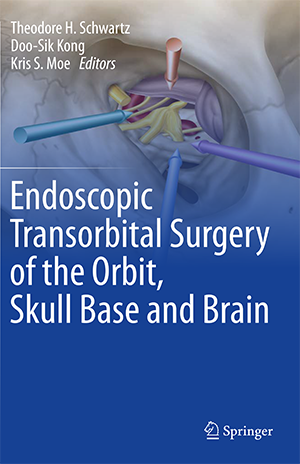Three of the world’s leading experts on endoscopic transorbital surgery — Theodore H. Schwartz, MD; Doo-Sik Kong, MD, PhD; and Kris S. Moe, MD — will soon release an innovative textbook to address this advanced surgical discipline. The book, Endoscopic Transorbital Surgery of the Orbit, Skull Base and Brain, will be published on September 29, 2024.
Dr. Schwartz, the David and Ursel Barnes Professor of Minimally Invasive Brain Surgery and vice chair of clinical research at Weill Cornell Medicine Neurological Surgery, has long been a leader in endoscopic approaches to the skull base. For nearly two decades he has directed an annual course in endoscopic surgical approaches, starting with endonasal and now including transorbital and supra-orbital approaches. His co-editors on this book have traveled to New York as guest faculty at these courses. Dr. Kong is professor of neurosurgery at Samsung Medical Center and the Sungkyunkwan University School of Medicine in Seoul and one of the leaders of minimally invasive brain surgery in Asia; Dr. Moe is professor of head and neck surgery and neurological surgery at the University of Washington, where his is chief of facial plastics and reconstructive surgery. With this book, the three leaders of this field have created the first reference work of its kind, designed to codify these new approaches for surgeons around the world.
Any surgeons who deal with pathologies of the skull base will benefit from this exhaustive volume, detailing the procedures that have been developed over the last decade through a collaboration of otolaryngologists, oculoplastic surgeons, and neurosurgeons. Since the skull base lies at the intersection of these specialties, no single discipline provides the level of training needed to reach the region and treat pathologies there. The book details the collaborative approaches needed for these technically demanding and often long and arduous procedures.
The editors and their colleagues have learned — and here demonstrate — that the orbit can be used as a minimally disruptive corridor to reach areas that are difficult to access through transcranial or endonasal approaches. In this book they explore the many advantages of the approach. Surgeons have used it to remove brain tumors of the frontal and temporal lobes, including those that extend through the middle cranial fossa and into the posterior fossa; clip aneurysms; treat seizure disorders; drain abscesses; repair CSF leaks; and repair skull fractures — all without the additional risks, trauma, and prolonged recovery of traditional open surgical techniques.
The book will be published by Springer on September 29, 2024.
Pre-order on Springer | Pre-order on Amazon | Pre-order on Barnes and Noble


